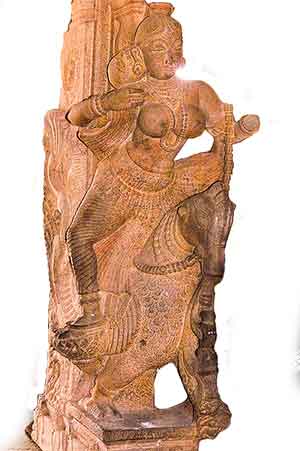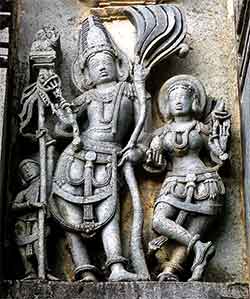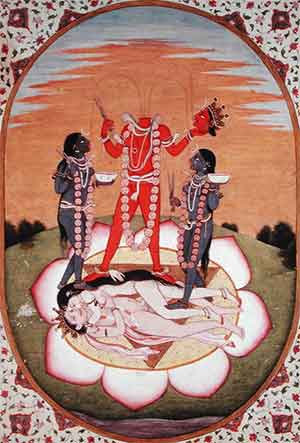
Hindu Goddess - Rati Devi

Literally speaking, "rati" means pleasure, desire, delight in something. In Indian traditions, the word is usually associated with sexual pleasure and is used to connote sexual union and the art and science of love making (rati-jnana).
In the Hindu pantheon, Rati is the goddess of love. She is exceedingly beautiful and feminine, yet rides upon a horse like a queen, denoting her Kshatriya origin as the daugher of Prajapati. She is famous in the legends associated with her as the wife of Manmatha, the god of love, who rides upon a chariot drawn by parrots and uses his love arrows to incite passion in people and gods. Hence, he is also known as Cupid or Kamadeva. Both Rati and Manmadha represent a couple in perfect love, harmony and conjugal bliss. They symbolize the ideal of perfection in love and conjugal relationship.
We do not find any reference to Rati and Manmatha in the Vedas. However, they appear in the Puranas, usually as side characters in the legends associated with Shiva and Parvathi, as the couple playing a dutiful role in bringing them together and making possible their marriage.
 Rati and Manmadha
Rati and Manmadha
In the Puranas we find many conflicting stories associated with the goddess. In some versions she is described as the daughter of Daksha Prajapati, created by him out of his own sweat. In other versions she was the daughter of Brahma Prajapati, who self-immolated herself when Brahma, her own father, felt lust towards her because of her beauty and killed himself out of shame. According to the legends, Vishnu revived both of them and gave her in marriage to Manmatha.
Rati also figures in the Puranas, in different versions of a legend associated with the marriage between Shiva and Parvati and the death of her husband. According to the most popular version, Parvathi wanted to win over Shiva and marry him, but Shiva was in deep meditation and would not pay her any attention. Manmatha tried to help Parvathi by inciting passions in Shiva and disturbing his meditation. Annoyed by his audacity, Shiva opened his third eye and burnt him to ashes. Aghast at his sudden demise, Rati beseeched Shiva to revive him. Shiva obliged and revived him, but made him invisible and without a body.
In some versions, Rati managed to revive her husband by performing severe penances. In the third version, upon her husband's death, she tried to self-immolate herself. Then, a heavenly voice urged her to wait until the marriage of Shiva and Parvathi, when he would be revived as destined.

The Bhagavata Purana states that Kama was reborn as Pradyumna, son of Krishna, while Rati was reborn as his wife, Mayavati. In a slightly different version mentioned in the Skanda Purana, Rati was held in hostage by a demon named Sambara due to a curse inflicted upon her by Narada. In accordance with the curse, she stayed in his house as Mayavati, acting as his maid, protected by the divine power of Shiva from all possible harm from the demon, until Pradyumna arrived on the scene and slew Sambara to rejoin his wife.
Because of her exceptional status, Rati appears in Hindu art, dance, literature and iconography, symbolizing both love and sexual passion. Her plight upon the death of her husband is described in a poetic detail by Kalidasa in his monumental work, Kumara Sambhava, associated with the birth and legend of Skanda, the elder son of Shiva. He images also appear in the temple sculpture and in tantric imagery as the goddess of love and sex. Symbolically, Rati represents, sexual passion, love, beauty, and a woman in perfect harmony and bliss with her lover or husband. Spiritually, she represents the impurities of rajas and tamas. In the Tantric imagery, the goddess Chinnamasta is depicted as standing upon copulating Rati and Manmadha, while she holds her own severed head in her left hand. In popular tradition, when people find a beautiful couple in harmony, they compare them to Rati and Manmadha.
Suggestions for Further Reading
- Gods and Goddesses of Hinduism
- About Goddess Parvathi or Shakti
- Hindu God Lord Shiva (Siva) - the Destroyer
- Hinduism - Gods and Goddess in the Vedas
- Gods of Hinduism - Brahma, the Creator
- Daksha, Daksha's Sacrifice and the Slaying of Daksha
- Rudra, Rudras the Gods of Hinduism
- Gods of Hinduism, the Eight Vasus
- Yakshas and Yakshinis
- The Concept of Atman or Eternal Soul in Hinduism
- The Problem of Maya Or Illusion and How To Deal With It
- Belief In Atman, The Eternal Soul Or The Inner Self
- Brahman, The Highest God Of Hinduism
- The Bhagavad Gita Original Translations
- The Bhagavadgita, Philosophy and Concepts
- Bhakti yoga or the Yoga of Devotion
- Hinduism And The Evolution of Life And Consciousness
- Why to Study the Bhagavadgita Parts 1 to 4
- Origin, Definition and Introduction to Hinduism
- Symbolic Significance of Numbers in Hinduism
- The Belief of Reincarnation of Soul in Hinduism
- The True Meaning Of Renunciation According To Hinduism
- The Symbolic Significance of Puja Or Worship In Hinduism
- Introduction to the Upanishads of Hinduism
- Origin, Principles, Practice and Types of Yoga
- Essays On Dharma
- Esoteric Mystic Hinduism
- Introduction to Hinduism
- Hindu Way of Life
- Essays On Karma
- Hindu Rites and Rituals
- The Origin of The Sanskrit Language
- Symbolism in Hinduism
- Essays on The Upanishads
- Concepts of Hinduism
- Essays on Atman
- Hindu Festivals
- Spiritual Practice
- Right Living
- Yoga of Sorrow
- Happiness
- Mental Health
- Concepts of Buddhism
- General Essays
Attribution: The images used in this essay are either in public domain are used under licensed under the Creative Commons Attribution-Share Alike 2.0 Generic license.